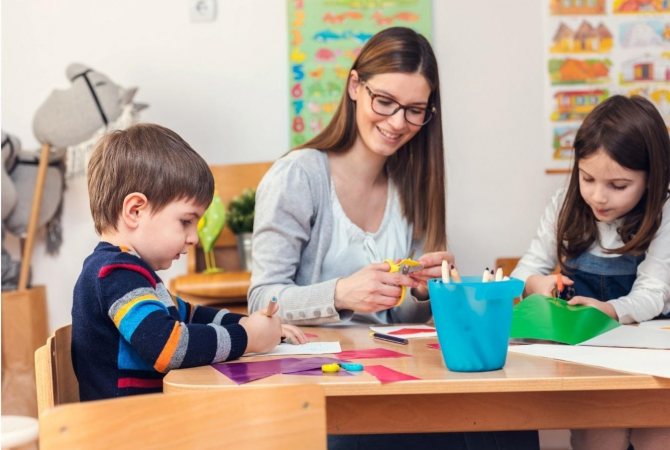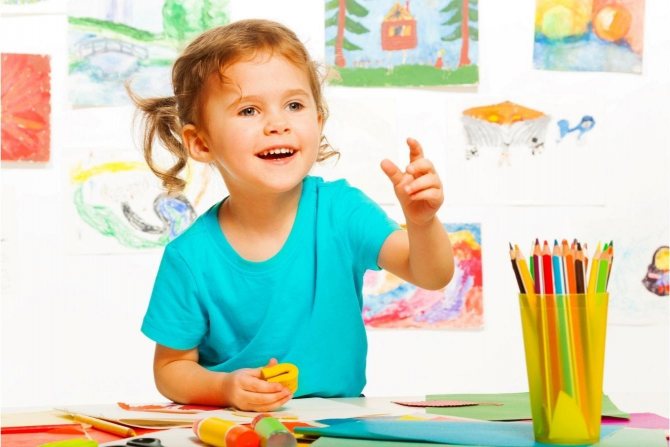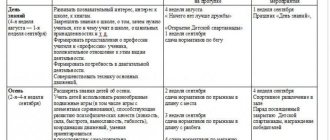- What is preschool pedagogy?
- Goals and objectives of preschool teachers
- 4 methods of preschool education
- What exactly do teachers use in the educational process and how to choose the right method?
A child aged 3-7 years old gets an entrance ticket to the world of society by visiting a kindergarten. In preschool educational institutions, the child gets the first idea of interaction in a team, independence and discipline, develops and masters skills so that later it is easier to adapt to school.
What methods do teachers use in preschool educational institutions during this important period of personality development, we will tell you today.
What is preschool pedagogy?

Preschool pedagogy
is a branch of general pedagogy that includes research into the theory of upbringing and teaching preschool children and involves the use of special tools and methods. Preschool pedagogy became an independent science only in the 19th century.
The main object of preschool pedagogy is the child from the moment of his birth to the school period. It is at this time that children form concepts and beliefs that will have a direct impact on the entire subsequent life of a person, therefore, educators and teachers of preschool educational institutions have a huge responsibility.
The main categories of preschool pedagogy are education, development, training and formation. If we reveal their essence in more detail, then:
- education
consists of purposeful, systematic and organized actions for the development and formation of the child’s personality; - development
involves quantitative and qualitative changes that occur with age under the influence of the educational process; - formation
- an organized process of managing a child’s life activity under the influence of educational measures, education and the social environment; - learning
is a detailed planned process of transferring knowledge, skills, and behavioral characteristics from teacher to child.
Goals and objectives of preschool teachers

The main goal of preschool education will be to promote self-realization and development of each person in a civilized society, therefore, teachers and educators in kindergartens try from an early age to introduce children to universal moral, cultural and educational values - kindness and honesty, love of neighbor, respect for parents , to hard work and diligence, curiosity and improvement of personal qualities, to mutual respect in relationships with other people, to responsibility, discipline and creativity.
Based on the goals, the most important tasks of preschool pedagogy will be:
- assess the personal qualities that can be developed in a child during the preschool period;
- justify the types and methods of educational activities;
- organize the educational process so that the child’s creative potential acquired in kindergarten is preserved throughout his entire education at school.
Of course, preschool age is a key period in the development of a child, therefore preschool teachers bear a huge responsibility to society, and in order to perform their tasks efficiently, they must have certain skills and competencies. Teachers at our academy will help you gain the necessary knowledge in the field of preschool pedagogy and psychology and master the profession of a preschool teacher (primary school teacher) in a professional retraining course.
And we will tell you what methods teachers use when working with preschoolers.
When setting goals and objectives for educational activities, remember! material on the topic
REMINDER
for preschool teachers
When setting goals and objectives for educational activities directly, remember:
- The goal is always the same.
- The tasks should be of a triune nature, i.e. should include an educational, developmental, educational orientation. In this case, there may be more than three tasks themselves.
- The formulation of educational objectives must correspond to program objectives and must begin with a verb.
- The choice of the right verb depends on the nature of the GCD you are planning: by communicating new knowledge, training or final.
Approximate formulations of educational objectives of GCD for communicating new knowledge:
“Update children’s knowledge about...”
“Create conditions for children to gain knowledge about...”
“Motivate children to study independently...”
“To give children the opportunity, with the help of an adult, to learn about...”
“To formulate in children the need to correctly use possessive pronouns in their own speech”
Approximate formulations of educational objectives of GCD of a training and final nature:
“Update children’s knowledge about...”
“Expand children’s knowledge0 ... through organizing independent experimental activities”
“To provide an opportunity to put into practice the acquired knowledge about...”
“To consolidate the ability in independent activities...”
- Developmental tasks are aimed, as a rule, at the development of higher mental functions (thinking, memory, imagination, attention), general, fine, articulatory motor skills, prosodic components of speech (voice, rhythm, tempo, intonation), speech breathing.
- The formulation of developmental objectives must correspond to program objectives and must begin with a verb.
- Depending on the extent to which the children have developed the function you want to work on, the choice of verb will be made:
- - if the function has not been formed, then the task will begin with the words “form ...”, “begin work on development ...”, etc.
— if the function is not sufficiently formed, or it is necessary to consolidate some skill, then the choice will be “continue to form...”, “continue to develop...”, “improve...”, etc.
- Educational tasks are, as a rule, aimed at developing the child’s personal qualities and his emotional and volitional sphere.
- The formulation of educational objectives must correspond to program objectives and must begin with a verb.
- Depending on the extent to which children have developed the quality (property) that you want to work on, the choice of verb will be made:
- if the quality (property) is not formed, then the task will begin with the words “form ...”, “educate ...”, etc.
- if the quality (property) is not sufficiently formed, or it is necessary to consolidate it, then the choice of verb will be “continue to form ...”, “continue to educate ...”, “improve ...”, etc.
When planning the course of direct educational activities, remember:
- The GCD should include the following main stages:
- Organizing time;
— updating existing knowledge;
- communicating the purpose of the educational activity (in a form accessible to children), in order to motivate children to be active during the educational process;
- communication of new knowledge, or training in the use of new knowledge in children’s own practical activities (depending on the nature of the educational activity);
- the result of the GCD.
- The inclusion of allocated physical minutes in the course of ECD is not necessary if during the ECD there is a constant change in types of activities.
During the GCD, remember:
- At any moment, children can offer you an educational and developmental situation that is not in YOUR plan. Don't miss it. Remember the proverb “A spoon is the road to dinner” and don’t be afraid to deviate from your notes! Children will assimilate knowledge acquired at the right time much better.
- Don't rush your children with answers!!!!! Take a break. Try to reformulate your question, because the lack of a child's answer may be due to an incorrectly asked question, and not due to ignorance.
- Never ask a question that can be answered with “yes” or “no.” It is pointless.
- Don't rush to answer children's questions. Try asking him in response: “What do you think?” and listen carefully to the child’s assumption, and then, together with him or with others, find the answer to the question in various sources or by conducting some kind of experiment.
- Provoke children to ask questions, especially at the stage of fixing difficulties in something. "You do not know? But what to do when you don’t know something? (“You can ask someone”) Ask me!”
When summing up the GCD, remember:
- Questions should not be aimed only at children retelling the main stages of an educational event.6 “Where were we?”, “What did we do?”, “Who came to visit us?” etc.
- Use more problematic questions, such as “What allowed us to help the bunny?”, “Why did we do this?”, “Is what you learned today important?”, “Why is this useful in life?”, “What was the task?” the most difficult thing for you? Why?”, “Which task did you like best? Why?”, “What would you like to tell the guys, Masha?”, “What should we do next time?”, “What will you tell your parents about our game today?” etc.
- Don’t praise all the children every time with the words “You’re all great!” Celebrate the specific merits of EACH child: “Dima, you came up with a great idea on how to cross the river”, “I was very pleased to see how Polina and Sasha agreed on who would draw first”, “Marina did a wonderful job of completing a difficult task...”, “Pasha made me happy today. Although he was not very successful in completing the task..., he showed a real example of how to overcome difficulties,” etc.
Enjoy communicating with children and then everything will definitely work out for you!!!
What exactly do teachers use in the educational process and how to choose the right method?

In practice, teachers and educators choose methods for teaching children, guided by the objectives of the educational process, as well as the age and individual characteristics of preschoolers. The choice of a specific technique depends on the upcoming lesson in kindergarten and its ultimate goals.
- Visual techniques
include observation (the skill of peering into the phenomenon of the surrounding world, noticing changes, additions, identifying the cause and drawing the right conclusion) and demonstration (visual representation of both familiar and still unknown objects).
- Practical techniques
involve performing exercises (repeated repetition of mental or practical actions for better assimilation), conducting experiments (research to acquire knowledge) and modeling (map, plan, manual).
- Through gaming techniques
imaginary situations are created (for example, a market game to study types of vegetables), and teachers also invite children to participate in didactic games (for better assimilation of knowledge).
- Verbal techniques
– this is a conversation, story and reading fiction (suitable for studying and remembering information, developing imagination and memory).
Of course, we, adults, must not forget that kindergarten is the child’s first experience in independent life, therefore, in addition to the necessary skills, educational methods should bring the child joy and pleasure from his first achievements.
Objectives of teaching preschoolers.
31. Formation of the child’s systemic ideas about himself and the environment.
2. Development of children's general outlook.
3. Formation of general and special skills and abilities that allow the child to be involved in various types of activities (motor, artistic and aesthetic, cognitive, play, labor, constructive, etc.).
4. Development of cognitive processes and mental operations.
5. Formation of the ability of preschoolers to organize their cognitive activity (prepare a place for classes, plan a sequence of actions, evaluate the progress and results of activities, work together and individually).
6. Formation of the child’s ability to listen, answer and ask questions, act according to instructions, accept and complete a learning task.
7. Development of curiosity and cognitive interests of children.
8. Development of the ability to creatively interpret acquired knowledge, skills and abilities.
9. Fostering a positive emotional attitude towards educational and cognitive activities, towards mastering new knowledge and experience, towards interaction with the teacher in the learning process.
10. Formation of general and special readiness of children for school
training.
A person-oriented model of interaction between an adult and a child is the basis of modern education for preschoolers.
• Educational and disciplinary model of interaction between an adult and a child
Goal: to equip children with ZUNs, to instill obedience.
Task: implement the program, satisfy the requirements of management and regulatory authorities.
The slogan is “Do as I do.”
Methods of interaction: instructions, explanations, prohibitions, demands, threats, punishments, notations, shouting. Children's activity is suppressed.
Tactics - dictatorship and guardianship.
Result: mutual alienation of adults and children.
• A personality-oriented model of interaction between adults and children is the basis for teaching preschoolers (Sh. A. Amonashvili, V. V. Davydov, V. A. Petrovsky, etc.)
Goal: to promote the development of the child as an individual.
Objectives: developing the child’s trust in the world, a sense of joy of existence, the formation of the beginnings of personality, the development of individuality).
The principle of interaction: “Not next to and not above, but together.”
Methods of interaction require the ability to take the child’s position, take into account his point of view and not ignore his feelings and emotions (transition from monologue to dialogue). View your child as a partner.
The tactic is cooperation.
Expected results: expansion of children's rights; overcoming possible egocentrism of children, forming a team; development of cognitive and creative abilities, liberation of imagination and thinking.
Basic principles of teaching preschool children:
1. The principle of educational training. The unity of education and training is based on the idea of enriching the spiritual world of the child.
2. The principle of developmental education. Involves learning at a high level of difficulty, based on the zone of proximal development using active learning techniques.
3. Scientific.
According to the research of A.P. Usova, in teaching preschoolers one cannot limit oneself to empirical knowledge about the external qualities and properties of objects and phenomena without highlighting their essential features; theoretical knowledge should be given that reflects the general dependencies between phenomena.
4. Visuals.
Corresponds to the basic forms of thinking of preschoolers (visual-effective, visual-figurative).
5. Activity and consciousness.
The use of entertaining and game material, the inclusion of various child activities in the course of learning (examination, play activities, exercises with material), alternating teaching children rational ways of solving problems with performing tasks of a creative nature.
6. Systematicity and consistency.
The sequence of training is laid down in the program for each section (a gradual transition from one knowledge to another, their expansion, complication).
7. Strength.
Constant repetition is necessary in order to better memorize, using a variety of methods.
8. Availability.
Correlation of content, volume of knowledge with the level of development and preparedness of children.
9. Taking into account the age and individual characteristics of children.
3



